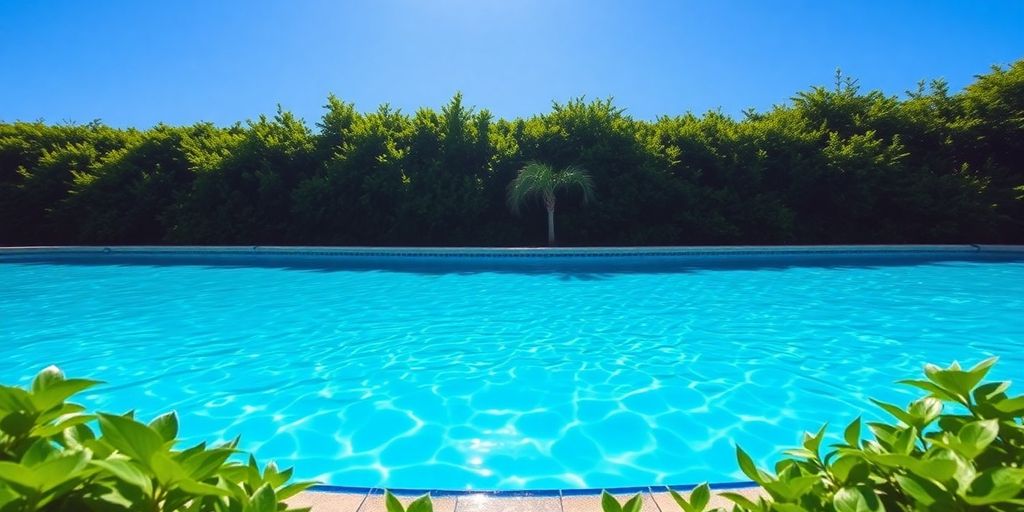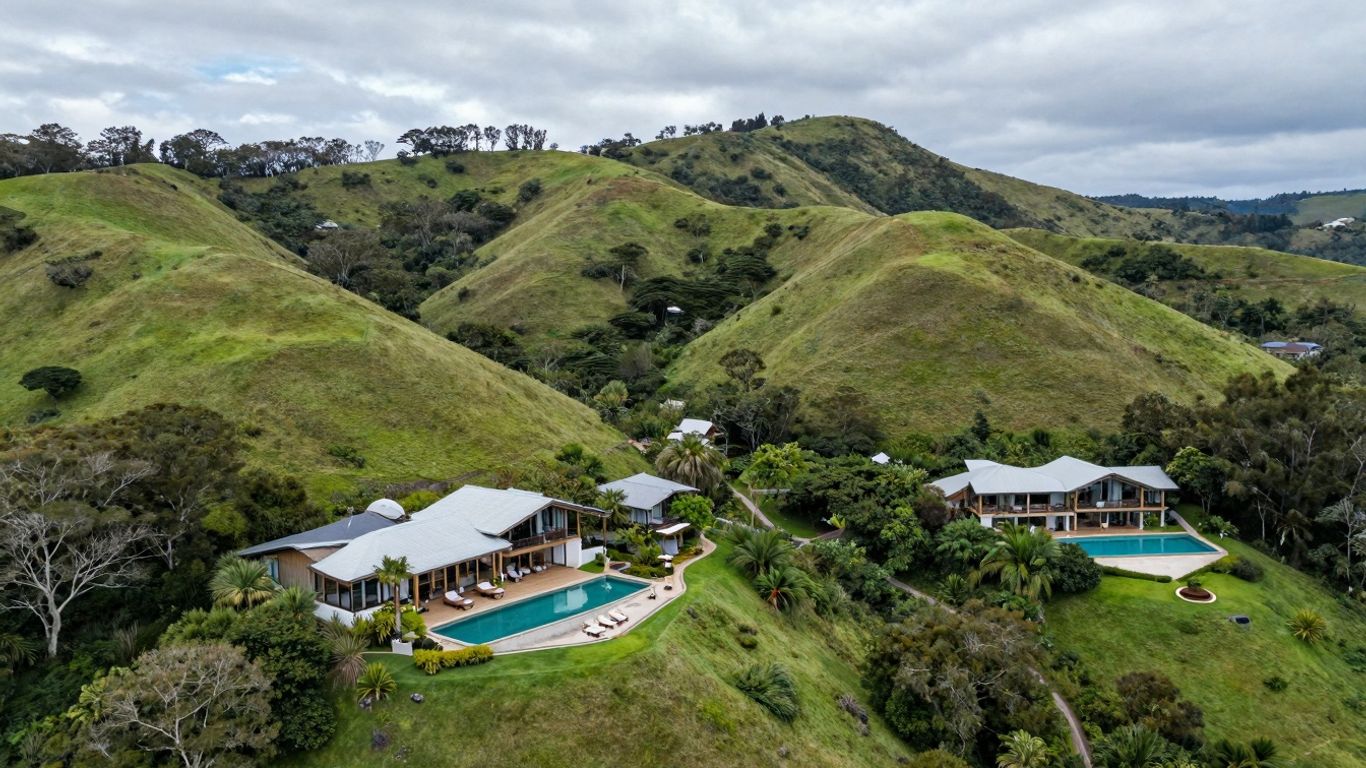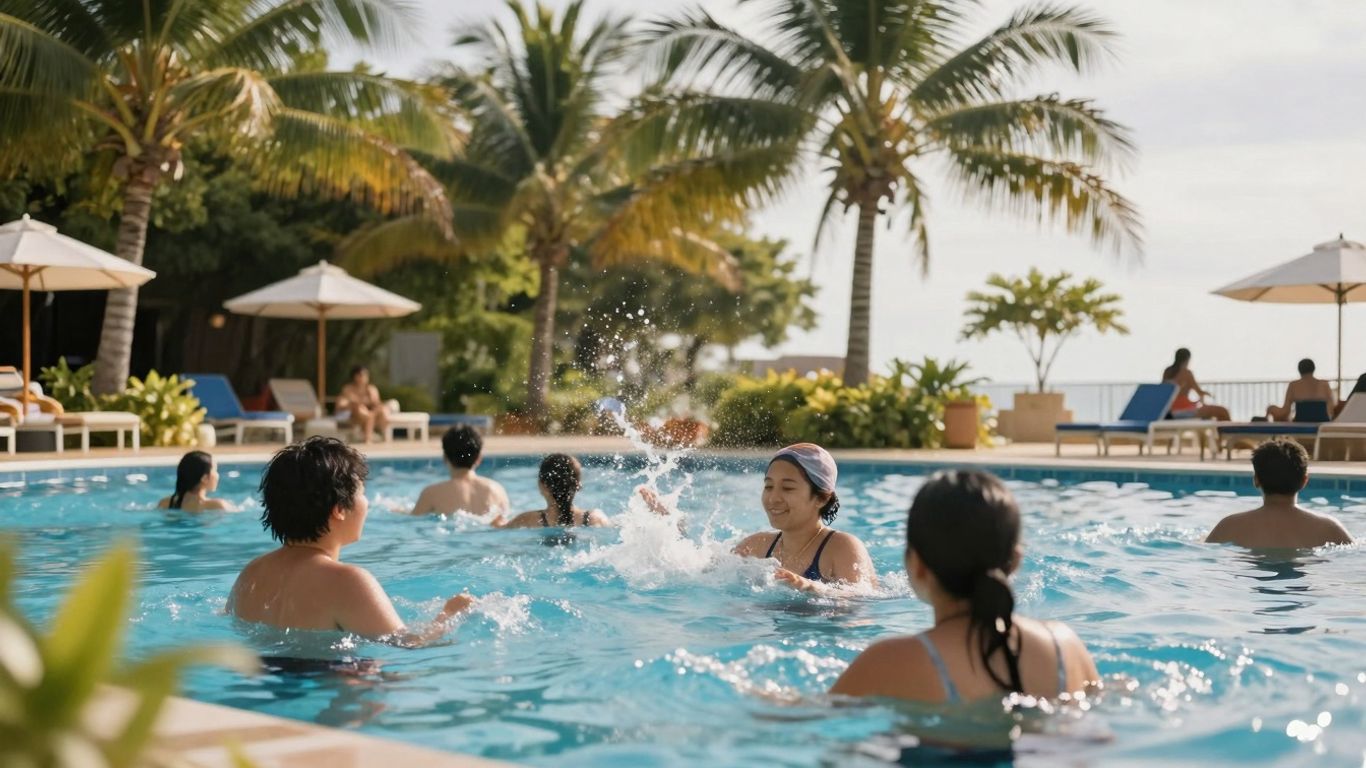G’day! So your swimming pool has gone a bit green? Happens to the best of us, especially after a bit of neglect or a sudden algae bloom. Don’t stress, though. Getting that water clear again is totally doable. This guide is all about helping you sort out your green swimming pool treatment, from figuring out what’s causing the mess to keeping it sparkling clean. Let’s get that pool looking inviting again, mate.
Key Takeaways
- Algae can grow anywhere water can go, so keeping things clean is key.
- Regularly brush and vacuum your pool to stop algae from getting a foothold.
- Clean your filter when the pressure gauge shows it’s needed – usually a 25% rise.
- Understand different algae types like mustard and black spot to treat them right.
- Consistent water testing and balancing are your best bet against future green pools.
Tackling That Green Swimming Pool Treatment

Righto, so your pool’s looking a bit like a frog’s holiday resort – green and murky. Don’t stress, it happens to the best of us. The first thing to figure out is where this algae is actually hanging out. Algae loves to hide in all sorts of nooks and crannies, from the pool walls and floor to even inside your pipes and filter. If water can get there, you can bet your bottom dollar algae can too.
Daily brushing is your best mate in this fight. It might sound like a bit of a chore, but giving your pool walls and floor a good scrub every day really helps break up any slimy stuff algae is using to protect itself. Think of it as giving it a good tickle so the chlorine can get to work.
Your filter is another big player. If it’s clogged up, it can’t do its job properly, and that’s when things go south. Keeping your filter clean and running smoothly is key to getting that water back to being clear. We’ll get into the nitty-gritty of how to do that in a bit.
Understanding Algae’s Hangouts
Algae can set up shop anywhere there’s water. This includes:
- Pool walls and floor
- Steps and ledges
- Grout lines and tile edges
- Inside pipes and plumbing
- The pool filter itself
The Importance of Daily Brushing
Brushing your pool surfaces daily is a simple yet effective way to dislodge algae and prevent it from forming stubborn biofilms. This action makes the algae more vulnerable to your sanitiser.
Filter Maintenance for Clear Water
A clean filter is vital for removing dead algae and other debris. Regularly cleaning or backwashing your filter prevents it from becoming a breeding ground for more problems and helps maintain water clarity. A dirty filter can’t effectively filter out the nasties, leading to that dreaded green tint.
Don’t underestimate the power of consistent, simple actions. Brushing and keeping your filter in check are your first lines of defence against a green pool.
Essential Steps for Green Pool Recovery
So, your pool’s looking a bit like a swamp monster’s spa day? Don’t stress, mate. Getting that green water back to sparkling clear is totally doable with a bit of elbow grease and the right approach. We’re talking about getting stuck into it, not just chucking in a few tablets and hoping for the best.
The SLAM Process Explained
The SLAM process, which stands for Shock Level And Maintain, is your go-to strategy for tackling serious algae problems. It’s a bit like giving your pool a super-strength cleanse. You’ll need to shock the water with a high dose of chlorine to kill off all that pesky algae. The key is to keep that chlorine level up until the water is completely clear and the algae is gone. This might take a few days, so be prepared to stick with it. You’ll also need to keep an eye on your water chemistry, especially your Free Chlorine (FC) and Combined Chlorine (CC) levels. You want your FC to be significantly higher than your CC, ideally with CC at 0.5 ppm or less, to show the algae is truly beaten. Remember to run your pump 24/7 during this process and keep brushing.
Daily Brushing and Vacuuming
While you’re in the thick of the SLAM process, or even just doing regular maintenance, daily brushing and vacuuming are your best mates. Brushing the pool walls and floor helps to dislodge any algae that’s clinging on, making it easier for your filter and chlorine to do their job. Think of it as giving the algae a good scrub so it can’t hide. Vacuuming, especially if you can do it to waste, helps remove dead algae and debris directly from the pool. If you’ve got stubborn bits that just won’t budge, a good stiff brush, maybe even a steel one for plaster pools, can make all the difference. It’s all about breaking up those biofilms that algae loves to use for protection. This is a key part of clearing a green swimming pool.
Backwashing Your Filter
Your pool filter is working overtime when you’ve got algae, so it needs a bit of TLC too. Backwashing is basically reversing the water flow through your filter to flush out all the gunk it’s collected. You’ll know it’s time to backwash when the pressure gauge on your filter rises about 8-10 PSI above its normal clean running pressure. Don’t wait too long, or your filter won’t be able to do its job properly. After backwashing, you might need to rinse it (if you have a multiport valve) before returning to normal filter mode. Keeping your filter clean is super important for pool filter maintenance.
Don’t forget to check all the nooks and crannies where algae likes to hide – think light niches, steps, drains, and skimmer throats. If water can get there, algae can too!
Identifying Stubborn Pool Stains

Righto, let’s talk about those stubborn marks that can pop up in your pool. Sometimes, despite your best efforts, you’ll find patches that just won’t budge. It’s a bit frustrating, isn’t it?
Mustard Algae vs. Black Spot
Figuring out what you’re dealing with is half the battle. Mustard algae often looks like yellow or brown dust that can be brushed away, though it might return if the water chemistry isn’t right. Black spot, on the other hand, is usually darker, more like a spot, and can be quite tough to remove, sometimes needing a good scrub with a steel brush. If you rub a bit of the stain on white paper and it leaves a green mark, it’s a strong indicator of black spot.
Dealing with Brown and Green Residue
When you’ve got brown or greenish gunk that’s really stuck fast, it can be a real pain. Brushing might help loosen it, but if it’s not coming off, you might need to look at your pool’s chemical balance. Sometimes, brown stains can be from metals like iron. A handy trick to check for this is to rub a bit of crushed Vitamin C tablet on the stain. If it starts to fade, you’re likely dealing with an iron issue. Remember though, you’ve got to sort out any algae problems first before tackling metal stains.
When to Seek Professional Advice
If you’ve tried a few things and those stains are still giving you grief, or if your water test results are all over the shop (like getting wildly different CYA readings from the same place), it might be time to call in the cavalry. Sometimes, a professional can spot what you’re missing or has access to stronger treatments. Don’t be afraid to get help to get your pool back to its best. For more on keeping your pool in top shape, check out this guide on pool stain treatment.
Achieving Crystal Clear Water Naturally
So, you’ve had a bit of a green situation and you’re keen to get back to that sparkling, inviting pool water. Good on ya! It’s totally possible to get your pool looking its best without resorting to harsh chemicals all the time. We’re talking about using smarter methods that are kinder to the environment and, let’s be honest, probably better for us too.
Cutting-Edge Water Treatment Methods
These days, there are some pretty clever ways to treat pool water that go beyond just chucking in chlorine. Think about how some industries are tackling water waste – they’re getting really good at cleaning up even the murkiest water. For instance, I heard about a mine site in the Hunter Valley that’s got this amazing water treatment plant. They’re taking water that’s basically sludge and making it so clear it could go back into local creeks. It’s all about advanced filtration and natural processes. We can borrow some of those ideas for our pools.
Eco-Friendly Pool Cleaning Solutions
When we talk about eco-friendly, we mean solutions that work with nature, not against it. This could involve using natural enzymes to break down oils and organic matter, or even exploring ozone or UV systems. These methods can significantly reduce the need for traditional chemicals. It’s about creating a balanced ecosystem in your pool, rather than just shocking it with treatments. Making the switch to greener options can really make a difference.
The Benefits of Green Cleaning
Why bother with green cleaning? Well, for starters, it’s often gentler on your skin and eyes. No more that chlorine smell that lingers for days! Plus, you’re reducing the amount of chemical runoff into the environment. It’s a win-win. You get a cleaner pool and you’re doing your bit for the planet. It might take a little adjustment to your routine, but the results are worth it. You’ll find your pool water feels softer and looks clearer than ever before, all thanks to these smarter, greener approaches. If you’re looking to recover a green pool, starting with these methods is a great idea.
Enhancing Your Pool’s Ambiance
Making your pool area a bit more special after dark can really change the whole vibe. It’s not just about having a clear pool; it’s about creating a spot you want to hang out in, even when the sun’s gone down. Think about how a bit of light can transform your backyard from just a place with a pool to a proper oasis.
The Magic of Underwater Lighting
Putting lights right in the pool is a ripper idea. They make the water glow, which is pretty cool for a night-time dip. These lights not only look fantastic, especially if you go for coloured ones, but they also make the pool safer. You can actually see where people are in the water, which is handy if it’s a bit dim out.
Spotlights for Poolside Features
Spotlights are great for drawing attention to specific things around your pool. Got a nice plant, a cool statue, or even your outdoor furniture you want to show off? Adjustable spotlights can be aimed just right. You can even point them at the pool itself when people are swimming. Using coloured lights here can really add to the atmosphere too.
Creating Atmosphere with Coloured Lights
Coloured lights are a game-changer for pool ambiance. Whether it’s underwater or spotlights, changing the colour of the light can completely alter the mood. You can go for calming blues and greens for a relaxed feel, or vibrant reds and purples for a bit of party energy. It’s a simple way to make your pool area feel more dynamic and inviting, turning a regular swim into a bit of an event. Proper pool water chemistry is key to keeping everything looking good, no matter the lighting.
Maintaining Your Pool’s Health
Keeping your pool in tip-top shape is all about regular attention, mate. It’s not just about getting rid of that green gunk; it’s about making sure your pool stays healthy and inviting all year round. Think of it like looking after a pet – a big, watery one that needs consistent care. If you slack off, you’ll end up with more problems than you started with, and nobody wants that.
Regular Water Testing
Testing your water regularly is the first line of defence. You wouldn’t drive your car without checking the oil, right? Same deal with the pool. You need to know what’s going on in there. Grab a test kit and check your levels at least a couple of times a week, especially during the warmer months when things can change fast.
- pH: Aim for 7.2-7.6. Too high or too low and your chlorine won’t work as well, plus it can irritate swimmers’ eyes.
- Total Alkalinity: This helps keep your pH stable. Keep it between 80-120 ppm.
- Chlorine (Free Chlorine): This is your main sanitiser. You want to keep this in the 1-3 ppm range for normal use, but you’ll need more if you’re fighting algae.
- Cyanuric Acid (CYA): This protects your chlorine from the sun’s UV rays. The ideal range is usually 30-50 ppm, but it depends on your chlorine type.
Balancing Your Pool Chemistry
Once you know your numbers, you can start balancing. It’s like a bit of a puzzle, really. If your pH is high, you add a pH reducer. If your alkalinity is low, you add an alkalinity increaser. It’s all about making small adjustments. Don’t go chucking in heaps of chemicals at once; you might make things worse.
Remember, when you’re dealing with a green pool, especially if you’re following a process like the SLAM Process, you’ll be adding a lot more chlorine than usual. Stick to the plan and test frequently. Don’t get sidetracked by testing other things until the water is clear and the algae is gone.
Preventing Future Algae Blooms
Prevention is definitely better than a cure, especially when it comes to algae. Once you’ve got your pool looking clear, you want to keep it that way. This means sticking to your regular testing and balancing routine. Make sure your filter is running long enough each day – usually 8-12 hours is good. Brushing the walls and floor weekly also helps stop any sneaky biofilms from forming where algae likes to hide. Using a good quality manual pool vacuum can also make a big difference in keeping the bottom clean. Keep an eye on your pool, and you’ll catch any little issues before they turn into a big green mess.
So, there you have it!
Keeping your pool sparkling without all the harsh chemicals is totally doable. It just takes a bit of know-how and sticking to a routine. Remember, a little effort goes a long way in keeping that water clear and inviting. So, ditch the worry and get ready to enjoy your backyard oasis. Happy swimming, everyone!
Frequently Asked Questions
Why is my pool water green and how do I stop it?
G’day! If your pool’s gone a bit green, it’s usually because of algae. Algae loves to hide in all sorts of spots where water can reach, like your pool walls, floor, and even in the pipes. Giving your pool a good scrub every day helps break up the slimy stuff algae uses to protect itself. And don’t forget to keep your filter clean – a dirty filter can’t do its job properly, leaving you with murky water.
What’s the SLAM process for a green pool?
When your pool is looking like a swamp, it’s time for the SLAM process. This means shocking the pool with extra chlorine to kill off the algae. You’ll need to run your pump a lot, brush and vacuum the pool daily to get rid of dead algae, and clean your filter when the pressure gauge goes up. It’s a bit of work, but it gets your pool sparkling again!
How can I tell if it’s mustard algae or black spot?
Spotting the difference between mustard algae and black spot can be tricky. Mustard algae often looks like yellow or brown dust and can be brushed away. Black spot, on the other hand, is a tougher, darker spot that might need a bit more effort to remove. If you’re unsure, or if the brown and green gunk on the bottom isn’t budging even with a good scrub, it might be time to call in a pro.
Can I really get clear pool water without using heaps of chemicals?
You bet! There are some ripper eco-friendly ways to keep your pool clean. Think natural treatments that are kinder to the environment and your wallet. Some methods use special enzymes or minerals to keep the water clear without harsh chemicals. It’s all about working with nature to get that crystal-clear water you’re after.
How can lighting make my pool area look better at night?
Lighting can totally transform your pool area at night! Underwater lights make swimming after dark magical and safer. You can also use spotlights to highlight cool features around your yard, like a special tree or some nice outdoor furniture. And for a bit of flair, coloured lights can create a fantastic atmosphere for parties or just a relaxing evening dip.
What’s the best way to keep my pool healthy all year round?
Keeping your pool healthy is all about regular checks. Test your water often to make sure the chemical levels are just right – not too much, not too little. This stops algae from coming back and keeps the water safe for swimming. Think of it like giving your pool a regular health check-up to prevent any big problems down the track.





